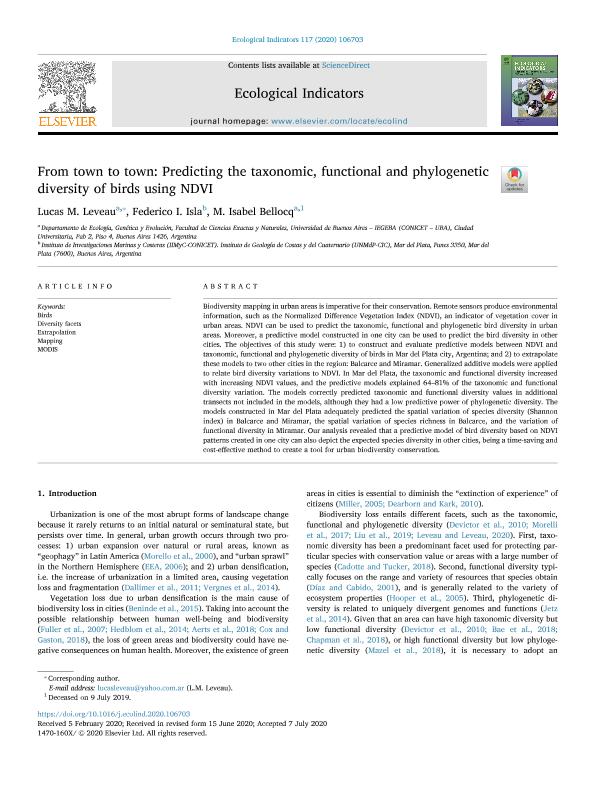Mostrar el registro sencillo del ítem
dc.contributor.author
Leveau, Lucas Matias

dc.contributor.author
Isla, Federico Ignacio

dc.contributor.author
Bellocq, Maria Isabel

dc.date.available
2021-09-07T13:28:47Z
dc.date.issued
2020-12
dc.identifier.citation
Leveau, Lucas Matias; Isla, Federico Ignacio; Bellocq, Maria Isabel; From town to town: Predicting the taxonomic, functional and phylogenetic diversity of birds using NDVI; Elsevier Science; Ecological Indicators; 119; 12-2020; 1-11
dc.identifier.issn
1470-160X
dc.identifier.uri
http://hdl.handle.net/11336/139785
dc.description.abstract
Biodiversity mapping in urban areas is imperative for their conservation. Remote sensors produce environmental information, such as the Normalized Difference Vegetation Index (NDVI), an indicator of vegetation cover in urban areas. NDVI can be used to predict the taxonomic, functional and phylogenetic bird diversity in urban areas. Moreover, a predictive model constructed in one city can be used to predict the bird diversity in other cities. The objectives of this study were: 1) to construct and evaluate predictive models between NDVI and taxonomic, functional and phylogenetic diversity of birds in Mar del Plata city, Argentina; and 2) to extrapolate these models to two other cities in the region: Balcarce and Miramar. Generalized additive models were applied to relate bird diversity variations to NDVI. In Mar del Plata, the taxonomic and functional diversity increased with increasing NDVI values, and the predictive models explained 64–81% of the taxonomic and functional diversity variation. The models correctly predicted taxonomic and functional diversity values in additional transects not included in the models, although they had a low predictive power of phylogenetic diversity. The models constructed in Mar del Plata adequately predicted the spatial variation of species diversity (Shannon index) in Balcarce and Miramar, the spatial variation of species richness in Balcarce, and the variation of functional diversity in Miramar. Our analysis revealed that a predictive model of bird diversity based on NDVI patterns created in one city can also depict the expected species diversity in other cities, being a time-saving and cost-effective method to create a tool for urban biodiversity conservation.
dc.format
application/pdf
dc.language.iso
eng
dc.publisher
Elsevier Science

dc.rights
info:eu-repo/semantics/openAccess
dc.rights.uri
https://creativecommons.org/licenses/by-nc-nd/2.5/ar/
dc.subject
BIRDS
dc.subject
DIVERSITY FACETS
dc.subject
EXTRAPOLATION
dc.subject
MAPPING
dc.subject
MODIS
dc.subject.classification
Conservación de la Biodiversidad

dc.subject.classification
Ciencias Biológicas

dc.subject.classification
CIENCIAS NATURALES Y EXACTAS

dc.title
From town to town: Predicting the taxonomic, functional and phylogenetic diversity of birds using NDVI
dc.type
info:eu-repo/semantics/article
dc.type
info:ar-repo/semantics/artículo
dc.type
info:eu-repo/semantics/publishedVersion
dc.date.updated
2021-08-19T20:34:19Z
dc.journal.volume
119
dc.journal.pagination
1-11
dc.journal.pais
Países Bajos

dc.journal.ciudad
Amsterdam
dc.description.fil
Fil: Leveau, Lucas Matias. Consejo Nacional de Investigaciones Científicas y Técnicas. Oficina de Coordinación Administrativa Ciudad Universitaria. Instituto de Ecología, Genética y Evolución de Buenos Aires. Universidad de Buenos Aires. Facultad de Ciencias Exactas y Naturales. Instituto de Ecología, Genética y Evolución de Buenos Aires; Argentina
dc.description.fil
Fil: Isla, Federico Ignacio. Consejo Nacional de Investigaciones Científicas y Técnicas. Centro Científico Tecnológico Conicet - Mar del Plata. Instituto de Investigaciones Marinas y Costeras. Universidad Nacional de Mar del Plata. Facultad de Ciencias Exactas y Naturales. Instituto de Investigaciones Marinas y Costeras; Argentina
dc.description.fil
Fil: Bellocq, Maria Isabel. Consejo Nacional de Investigaciones Científicas y Técnicas. Oficina de Coordinación Administrativa Ciudad Universitaria. Instituto de Ecología, Genética y Evolución de Buenos Aires. Universidad de Buenos Aires. Facultad de Ciencias Exactas y Naturales. Instituto de Ecología, Genética y Evolución de Buenos Aires; Argentina
dc.journal.title
Ecological Indicators

dc.relation.alternativeid
info:eu-repo/semantics/altIdentifier/url/https://www.sciencedirect.com/science/article/abs/pii/S1470160X20306403
dc.relation.alternativeid
info:eu-repo/semantics/altIdentifier/doi/https://doi.org/10.1016/j.ecolind.2020.106703
Archivos asociados
